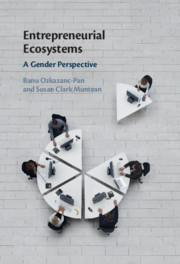Book contents
- Entrepreneurial Ecosystems
- Entrepreneurial Ecosystems
- Copyright page
- Contents
- Tables
- Preface
- 1 Introduction
- 2 Entrepreneurial Ecosystems
- 3 Understanding Gender and Inclusion in Entrepreneurial Ecosystems
- 4 Individual-Level Dynamics
- 5 Organizational-Level Dynamics
- 6 Gendering Institutions and Institutional Analysis
- 7 Intersectional Analysis
- 8 Holistic Solutions for Inclusive Economic Development through Entrepreneurship
- Index
- References
8 - Holistic Solutions for Inclusive Economic Development through Entrepreneurship
Published online by Cambridge University Press: 20 October 2021
- Entrepreneurial Ecosystems
- Entrepreneurial Ecosystems
- Copyright page
- Contents
- Tables
- Preface
- 1 Introduction
- 2 Entrepreneurial Ecosystems
- 3 Understanding Gender and Inclusion in Entrepreneurial Ecosystems
- 4 Individual-Level Dynamics
- 5 Organizational-Level Dynamics
- 6 Gendering Institutions and Institutional Analysis
- 7 Intersectional Analysis
- 8 Holistic Solutions for Inclusive Economic Development through Entrepreneurship
- Index
- References
Summary
This chapter examines all three levels to present a holistic framework for understanding gender in relation to entrepreneurial ecosystems and policies for supporting inclusive economic development. It builds off the authors’ previous research in this area within the technology startup sector. The chapter provides effective approaches for building inclusive entrepreneurial ecosystems that range from individual approaches to organizational ones and, finally, to approaches by policymakers at local, state, and country levels. The chapter also outlines how gender should be an important dimension of policy efforts aimed at helping cities, states, and nations combat rising economic inequality in the midst of economic development efforts. More urgently, the impact of the ongoing pandemic is also examined given the gendered outcomes it will likely have on entrepreneurial success.
- Type
- Chapter
- Information
- Entrepreneurial EcosystemsA Gender Perspective, pp. 219 - 252Publisher: Cambridge University PressPrint publication year: 2021



